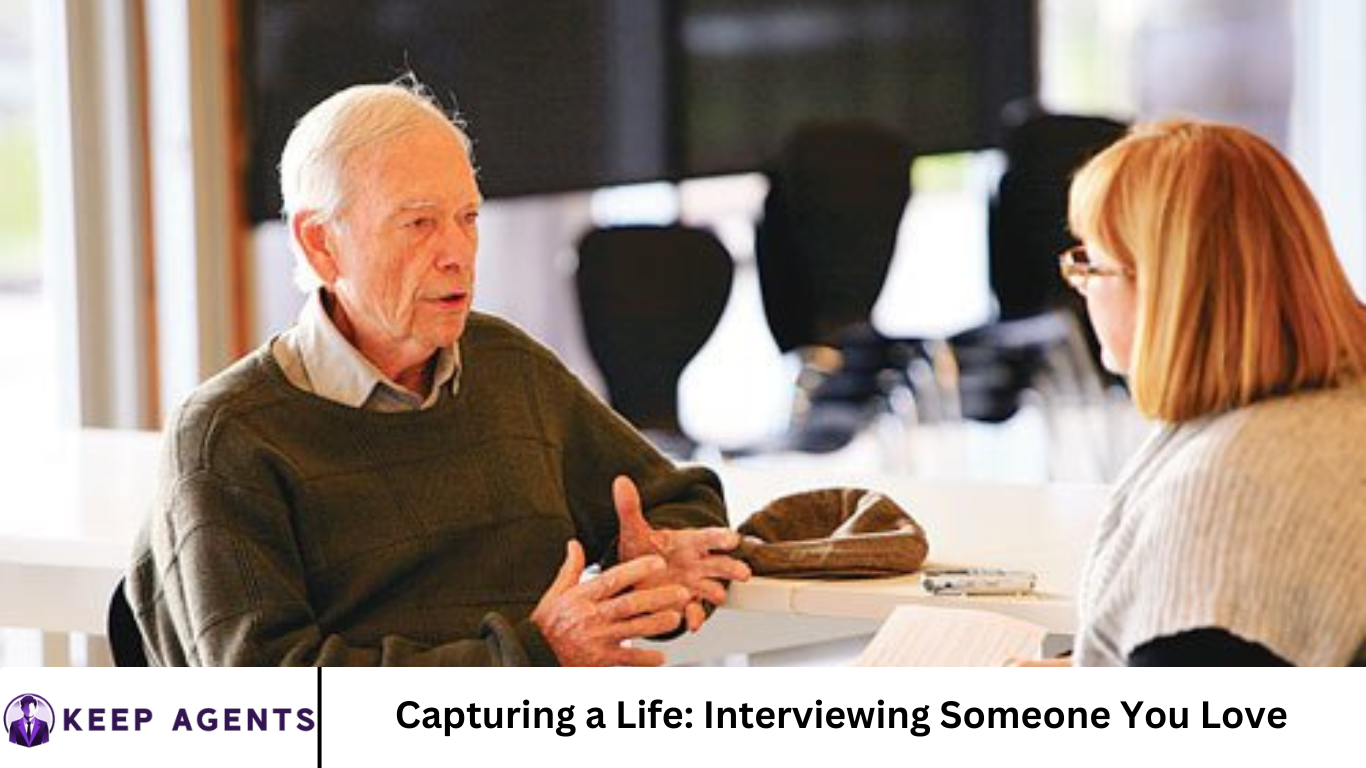Fast-paced digital world, we often forget the value of sitting down face-to-face with the people we love and simply listening to their stories. Our parents, grandparents, aunts, uncles, and even close friends carry within them rich life experiences that often go untold.
Interviewing someone you love isn’t just a meaningful act of love—it’s also an essential step in preserving your family history. Whether you’re documenting stories for a keepsake book, a family archive, or a personal podcast.
Learning how to interview a loved one effectively can be life-changing. This guide will walk you through the importance of capturing life stories, how to prepare, what to ask, and how to turn the experience into a timeless treasure for generations.
More Read: How to Write a Compelling Family History Book
Why Interviewing a Loved One Matters
1. Preserving Family History
Every family has a story, but unless it’s recorded, much of it may be forgotten. By capturing the memories, traditions, and perspectives of older family members, you’re creating a bridge between generations and preserving your legacy.
2. Honoring Their Journey
Interviewing a loved one offers them an opportunity to reflect on their life and feel seen, valued, and heard. It’s a powerful act of recognition that can have a healing and affirming effect.
3. Deepening Relationships
The process of listening with care strengthens bonds. It brings you closer emotionally and often reveals new dimensions of your loved one’s character you may not have known before.
4. Leaving a Legacy
The stories you capture become a priceless heirloom for children, grandchildren, and great-grandchildren. These narratives help future generations understand who they are and where they come from.
How to Prepare for a Life Story Interview
1. Choose the Right Person
Think about whose stories are at risk of being lost. Grandparents are often the first choice, but don’t overlook others—your parents, a mentor, a family friend, or even a sibling can have stories worth preserving.
2. Set a Purpose
Are you documenting a full life story? Focusing on a specific period or event? Creating content for a memory book, podcast, or documentary? Your goals will guide the structure and tone of your interview.
3. Plan Ahead
Pick a quiet, comfortable setting, free from interruptions. Decide whether you’ll use audio, video, or notes to capture the conversation. Bring any tools you might need, such as a recording device, notepad, camera, or your Life Story Interview Kit.
4. Prepare Questions
Have a mix of open-ended questions that cover different aspects of life. Group them into themes like:
- Childhood and Family
- Education and Career
- Love and Relationships
- Challenges and Triumphs
- Personal Beliefs and Values
- Reflections and Wisdom
Here are some example questions:
- What’s your earliest memory?
- What did your childhood home look like?
- Who influenced you the most growing up?
- How did you meet your partner?
- What was the happiest moment of your life?
- What lessons have you learned that you’d want others to know?
Interviewing Techniques to Capture Deep, Authentic Stories
1. Create a Safe Space
Start with small talk or familiar topics. Use body language, tone, and facial expressions to show that you’re engaged. Make it clear there’s no rush and no judgment.
2. Listen More Than You Speak
Practice active listening. Nod, smile, and offer affirmations like “That’s interesting” or “Tell me more.” Resist the urge to interrupt or fill in gaps—silence often leads to deeper reflections.
3. Ask Follow-Up Questions
If something piques your curiosity, dive deeper. Ask questions like:
- “What did that feel like?”
- “Why do you think that happened?”
- “How did that change you?”
These follow-ups often lead to powerful moments of self-discovery and storytelling.
4. Be Flexible
Your loved one may bring up memories you didn’t anticipate. Let the conversation flow naturally, even if it strays from your original list. Sometimes, the best stories are unplanned.
5. Respect Emotions
Some stories may bring up grief, regret, or trauma. Allow space for emotions. Offer tissues, be empathetic, and remind them they don’t have to answer anything they’re not comfortable with.
Recording Tips for High-Quality Results
1. Use Reliable Equipment
Smartphones can work well, but external microphones greatly improve sound quality. For video, use a tripod and soft lighting. Always test your setup before starting.
2. Record in a Quiet Space
Choose a room with minimal background noise. Avoid kitchens, fans, and ticking clocks. Place soft items (like pillows or curtains) nearby to dampen echoes.
3. Back Everything Up
Save your recordings to the cloud, a hard drive, and an external backup. Consider transcribing the audio for easier access and future projects.
Turning the Interview into a Legacy Project
1. Transcribe or Edit the Interview
Clean up the recording by removing pauses, filler words, or background noise. Use transcription software or services to turn the conversation into text. You can also organize the content into chapters or themes.
2. Create a Life Story Book or Video
With transcripts and photos, you can create a memory book, video tribute, or digital archive. Add visuals like old family photos, documents, or heirlooms to enrich the narrative.
3. Share with Family
Make copies for relatives, upload the interview to a family archive, or organize a special “Story Night” to celebrate and share the stories. These gatherings can spark more storytelling and deepen family connections.
Overcoming Common Challenges
1. “They Don’t Want to Talk About Themselves.”
Start with light, fun questions to ease them in. Explain that you’re not looking for perfection—just memories and honest reflections. Sometimes, all they need is reassurance that their story matters.
2. “They Don’t Remember Much.”
Photos, music, objects, or places from the past can jog memories. Try using a memory prompt deck or a themed Life Story Kit to inspire reflection.
3. “We Don’t Have Time.”
Even short conversations matter. Consider breaking the interview into smaller sessions. Just 20 minutes a week can lead to hours of preserved stories over time.
Frequently Asked Question
What’s the best way to start a life story interview with a loved one?
Begin with light, non-invasive questions that spark positive memories—such as childhood games, favorite foods, or the story behind a family tradition. Starting casually helps your loved one relax and opens the door for deeper storytelling later.
What kind of questions should I ask during the interview?
Focus on open-ended questions that encourage reflection and storytelling. Group them by theme:
- Childhood: “What was your neighborhood like growing up?”
- Love: “How did you meet your partner?”
- Work: “What was your first job, and how did it shape you?”
- Wisdom: “What life lessons would you pass on?”
How do I handle sensitive or emotional topics during the interview?
Approach delicate topics gently, and always respect your loved one’s comfort level. Let them skip any question they’re not ready to answer. If emotions surface, allow space for silence, offer empathy, and remind them there’s no pressure to share more than they want.
Should I record the interview, and if so, how?
Yes, recording is highly recommended to preserve their exact words and emotions. Use a smartphone, voice recorder, or video camera in a quiet space. Always ask for permission first. Back up recordings immediately to avoid loss.
What if my loved one doesn’t think their story is interesting?
Many people underestimate the value of their life experiences. Reassure them that their story matters—not just for facts, but for the insight, humor, and emotion it offers. Sometimes, all they need is to be heard to realize how much they have to share.
How long should each interview session last?
Aim for 30 to 60 minutes per session, depending on your loved one’s energy and attention span. It’s often better to do multiple shorter interviews than one long session, especially with older adults.
What should I do with the stories after the interview?
Transcribe or edit the recordings and organize them into a legacy project—a printed memory book, a family website, a video montage, or even a podcast. Share copies with family members and preserve them in a safe place for future generations.
Conclusion
Capturing a life story is one of the most generous and meaningful things you can do for someone you love—and for yourself. In an age where we record everything but often forget the voices that matter most, interviewing a loved one helps you reclaim connection, empathy, and history. The value of a life story is not just in the dates and events, but in the emotion, resilience, humor, and humanity embedded in every tale. When you sit down with someone and say, “Tell me about your life,” you’re not just collecting facts—you’re honoring a life fully lived. So don’t wait for the perfect moment. Pick up the phone, schedule the visit, ask the first question. The memories are there, waiting to be shared—and treasured forever.


